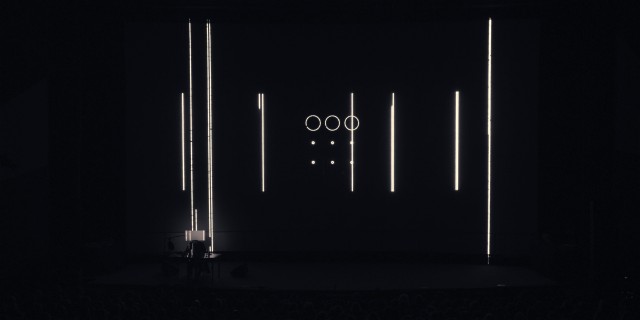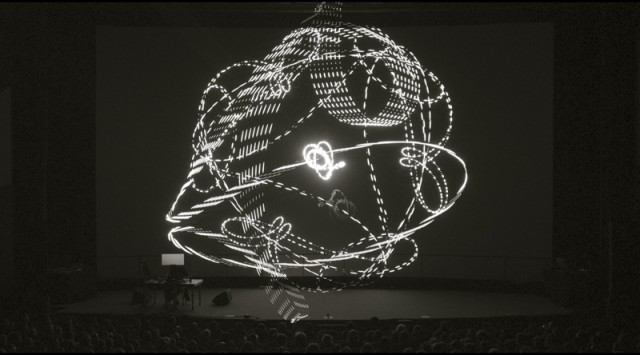Give Robert Henke a computer, some lasers, and some time to make his own tools as well as his own music, and wonderful things result. In a new video (German, with English subtitles), he gives a master class not so much in technology as the philosophy of using that technology.
Robert Henke – now increasingly in the public eye under his full name and not “co-founder, Monolake” or “co-founder, Ableton” attached with it – has for years gone way beyond the club floor. Even apart from experimental club music or elaborate multichannel audio experiments, you see his work accompanied by dancing arrays of balloons, or animated visualization, or gyrating bars of light. In Lumière, the audience is treated to frickin’ lasers.
But in the tight duet of sight and sound, Robert is playing with structure, focusing his intense compositional discipline like a … well, okay, like a laser beam.
Immersive audiovisual artwork is often seen as some kind of end in itself – it has commercial value, of course; it gets you programmed on festivals. It’s dazzling and spectacular, and the ritual of spectacle is its own cultural signifier. But it’s also clear that this isn’t want drives Robert when you hear him talk about his work.
And Robert, perhaps like the rest of us, has to deal with the greatest artistic demon of all: choice. From the video:
The problem with electronic music is you have too many options.
And that those many options often make it hard for you to make a decision.
My feeling is the fact that so much of electronic club music sounds the same stems from this fear.
You have all these options and what do you do? You just do what you know works.
30dez13 – Robert Henke (english subtitles) from 6sept13 on Vimeo.
Having come from classical acoustic composition and other creative endeavors, I would almost replace the words “electronic music” in the above sentence with “creating art.” (Composers, even bound by the peculiar limitations of the French Horn and its player, still agonize similarly over the question of choice.)
What these lasers and such do, then, is to provide limiting structure. And structure of some sort, Robert says in the video, is what drives him:
I try to find a context of some sort into which I can put my own creation while I’m creating it. This context then becomes an auxiliary construction which excludes certain things. To say, no, I won’t go this way, I’ll take another direction.
Robert rebels in the video against “intuition” and the danger of arbitrary sounds. But I don’t know that these are mutually exclusive aims. I’d even argue the free exercise of musical intuition requires constraints, which may be what Robert is indirectly getting at. A jazz pianist’s freedom comes partly from being able to constrain performance with rigid harmonic structure, with a specific scale – and then against those boundaries, anything goes. In electronic music, this can be as simple as improvising on (or composing with) a knob or parameter. “Intuition” in the above video perhaps simply means responding to open-ended choices with random, impulsive work.
In other words, different artists might frame “structure” and “intuition” very differently than Robert does in this video, but partly having to do with where they set up the bounds of their output. And a great deal of what I hear in Robert’s music, at least, is deeply intuitive – maybe benefiting from the structures he creates. Having too many choices, paradoxically, is the enemy of intuition. With limited choice, our intuition thrives.
This all matters, because much of the video is spent talking about the act of programming, of creating custom tools and musical and visual structures. And for that to be “relaxing” as Robert says is not so much about technical expertise as it is about the comfort with the creative process that results. Programming is nothing if not active decision-making.
CDM and Resident Advisor host Robert tomorrow in the MusicMakers Hacklab – that’s 17h at Kunstquartier Bethanien if you’re in Berlin for CTM. We’ll have audio of that conversation for everyone shortly thereafter.
MusicMakers Hacklab Conversations, Wednesday 29 January
I’m pleased Robert agreed to come along. He’s doing a lot of talking these days, but I’m glad he’s doing a little more, as I know we’ll enjoy it.
Lumière is part of the CTM programming Sunday night. We’ll have documentation of that soon.
http://www.monolake.de/concerts/lumiere.html
CTM Closing Concert


